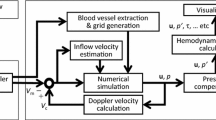Abstract
Prevention and early detection of atherosclerosis are critical for protection against subsequent circulatory disease. In this study, an automated two-dimensional ultrasonic-measurement-integrated (2D-UMI) blood flow analysis system for clinical diagnosis was developed, and the feasibility of the system for hemodynamic analysis in a carotid artery was revealed. The system automatically generated a 2D computational domain based on ultrasound color Doppler imaging and performed a UMI simulation of blood flow field to visualize hemodynamics in the domain. In the UMI simulation, compensation of errors was applied by adding feedback signals proportional to the differences between Doppler velocities by measurement and computation while automatically estimating the cross-sectional average inflow velocity. The necessity of adjustment of the feedback gain was examined by analyzing blood flow in five carotid arteries: three healthy, one sclerosed, and one stenosed. The same feedback gain was generally applicable for the 2D-UMI simulation in all carotid arteries, depending on target variables. Thus, the present system was shown to be versatile in the sense that the parameter is patient independent. Moreover, the possibility of a new diagnostic method based on the hemodynamic information obtained by the 2D-UMI simulation, such as a waveform of the cross-sectional average inflow velocity and wall shear stress distributions, was suggested.






Similar content being viewed by others
References
Filipovic N, Teng ZZ, Radovic M, Saveljic I, Fotiadis D, Parodi O (2013) Computer simulation of three-dimensional plaque formation and progression in the carotid artery. Med Biol Eng Comput 51:607–616
Ford MD, Xie YJ, Wasserman BA, Steinman DA (2008) Is flow in the common carotid artery fully developed? Physiol Meas 29:1335–1349
Funamoto K, Hayase T (2013) Reproduction of pressure field in ultrasonic-measurement-integrated simulation of blood flow. Int J Numer Methods Biomed Eng 29:726–740
Funamoto K, Hayase T, Shirai A, Saijo Y, Yambe T (2005) Fundamental study of ultrasonic-measurement-integrated simulation of real blood flow in the aorta. Ann Biomed Eng 33:415–428
Funamoto K, Hayase T, Saijo Y, Yambe T (2006) Numerical study on variation of feedback methods in ultrasonic-measurement-integrated simulation of blood flow in the aneurysmal aorta. JSME Int J, Ser C 49:144–155
Funamoto K, Hayase T, Saijo Y, Yambe T (2008) Numerical experiment for ultrasonic-measurement-integrated simulation of three-dimensional unsteady blood flow. Ann Biomed Eng 36:1383–1397
Funamoto K, Hayase T, Saijo Y, Yambe T (2009) Numerical experiment of transient and steady characteristics of ultrasonic-measurement-integrated simulation in three-dimensional blood flow analysis. Ann Biomed Eng 37:34–49
Funamoto K, Hayase T, Saijo Y, Yambe T (2011) Numerical analysis of effects of measurement errors on ultrasonic-measurement-integrated simulation. IEEE Trans Biomed Eng 58:653–663
Gelfand BD, Epstein FH, Blackman BR (2006) Spatial and spectral heterogeneity of time-varying shear stress profiles in the carotid bifurcation by phase-contrast MRI. J Magn Reson Imaging 24:1386–1392
Hayase T, Humphrey JAC, Greif R (1992) A consistently formulated QUICK scheme for fast and stable convergence using finite-volume iterative calculation procedures. J Comput Phys 98:108–118
Hoi Y, Wasserman BA, Lakatta EG, Steinman DA (2010) Carotid bifurcation hemodynamics in older adults: effect of measured versus assumed flow waveform. J Biomech Eng 132:071006
Kamenskiy AV, Dzenis YA, Mactaggart JN, Desyatova AS, Pipinos II (2011) In vivo three-dimensional blood velocity profile shapes in the human common, internal, and external carotid arteries. J Vasc Surg 54:1011–1020
Lee SW, Antiga L, Steinman DA (2009) Correlations among indicators of disturbed flow at the normal carotid bifurcation. J Biomech Eng 131:061013
Manbachi A, Hoi Y, Wasserman BA, Lakatta EG, Steinman DA (2011) On the shape of the common carotid artery with implications for blood velocity profiles. Physiol Meas 32:1885–1897
Morbiducci U, Gallo D, Ponzini R, Massai D, Antiga L, Montevecchi FM, Redaelli A (2010) Quantitative analysis of bulk flow in image-based hemodynamic models of the carotid bifurcation: the influence of outflow conditions as test case. Ann Biomed Eng 38:3688–3705
Moyle KR, Antiga L, Steinman DA (2006) Inlet conditions for image-based CFD models of the carotid bifurcation: is it reasonable to assume fully developed flow? J Biomech Eng 128:371–379
Patankar SV (1980) Numerical heat transfer and fluid flow. Hemisphere Pub. Corp, Washington DC
Poepping TL, Rankin RN, Holdsworth DW (2010) Flow patterns in carotid bifurcation models using pulsed doppler ultrasound: effect of concentric vs. eccentric stenosis on turbulence and recirculation. Ultrasound Med Biol 36:1125–1134
Press WH, Flannery BP, Teukolsky SA, Vetterling WT (1986) Numerical recipes: the art of scientific computing. Cambridge University Press, Cambridge, pp 274–282
Reneman RS, Hoeks APG (2008) Wall shear stress as measured in vivo: consequences for the design of the arterial system. Med Biol Eng Comput 46:499–507
Santhiyakumari N, Rajendran P, Madheswaran M, Suresh S (2011) Detection of the intima and media layer thickness of ultrasound common carotid artery image using efficient active contour segmentation technique. Med Biol Eng Comput 49:1299–1310
Schneider GE, Zedan M (1981) A modified strongly implicit procedure for the numerical solution of field problems. Numer Heat Transfer 4:1–19
Steinman DA (2002) Image-based computational fluid dynamics modeling in realistic arterial geometries. Ann Biomed Eng 30:483–497
The Joint Committee of “The Japan Academy of Neurosonology” and “The Japan Society of Embolus Detection and Treatment” on Guideline for Neurosonology (2006) Carotid ultrasound examination. Neurosonology 19:49–69
Tortoli P, Michelassi V, Bambi G, Guidi F, Righi D (2003) Interaction between secondary velocities, flow pulsation and vessel morphology in the common carotid artery. Ultrasound Med Biol 29:407–415
Wake AK, Oshinski JN, Tannenbaum AR, Giddens DP (2009) Choice of in vivo versus idealized velocity boundary conditions influences physiologically relevant flow patterns in a subject-specific simulation of flow in the human carotid bifurcation. J Biomech Eng 131:021013
Acknowledgments
Part of this study was supported by Grant-in-Aid for Scientific Research (B) (24360064). All computations were performed using the supercomputer system at the Advanced Fluid Information (AFI) Research Center, Institute of Fluid Science, Tohoku University.
Author information
Authors and Affiliations
Corresponding author
Rights and permissions
About this article
Cite this article
Kato, T., Funamoto, K., Hayase, T. et al. Development and feasibility study of a two-dimensional ultrasonic-measurement-integrated blood flow analysis system for hemodynamics in carotid arteries. Med Biol Eng Comput 52, 933–943 (2014). https://doi.org/10.1007/s11517-014-1193-3
Received:
Accepted:
Published:
Issue Date:
DOI: https://doi.org/10.1007/s11517-014-1193-3




